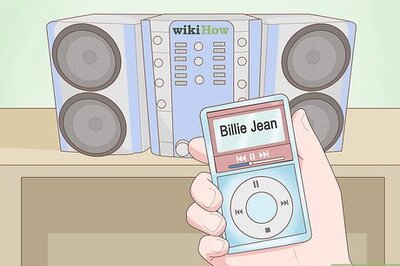
views
What does righty tighty lefty loosey mean?
"Righty tighty left loosey" explains how to tighten or loosen a threaded part. For example, if you want to tighten a screw, you would rotate the screw to the right. If you want to loosen it, you would rotate it to the left. This is because most threaded parts – including screws, nuts, bolts, and connectors – have threads that slant upward to the right when you orient them with the top pointing up. Examples of common household items that use threaded parts include light bulb sockets, garden hoses, cabinet door knobs, furniture screws, and water supply valves.
How to Visualize Righty Tighty Lefty Loosey
Focus on the top of the threaded part and imagine moving it right or left. Keep its starting position in mind as you rotate it right to tighten or left to loosen. Avoid focusing on the bottom of the part or you're more likely to become confused. Some people look at the bottom of a screw while they're turning it right to tighten it, and they think that because the bottom of the screw is technically rotating to the left, that means they're turning it the wrong way. For this reason, not everyone views tightening or loosening a threaded part by turning it right or left as an intuitive thought process.
Imagine turning the threaded part clockwise or counterclockwise. Rotating a threaded part is similar to the hands on a clock rotating around the center of the clock face, so this is often an easier way for people to understand the concept of righty tighty lefty loosey. Instead of thinking in terms of "right" and "left," visualize turning the threaded part clockwise (right) to tighten it or counterclockwise (left) to loosen it. Another way to remember that turning the part clockwise will tighten is to say the phrase, "Time is always tight." The hands on a clock – i.e., time – move clockwise around the clock face. So to tighten something, you must movie it with the hands of the clock – i.e., the passage of time.
Is it always righty tighty lefty loosey?
Some threaded parts use the rule "lefty tighty righty loosey." These are left-handed or reverse threads, meaning the threads on a part slope upward to the left instead of to the right. They're used in some automotive parts, gas tanks, and other applications where external vibrations or rotations might cause right-handed threads to loosen on their own. Automotive parts that use left-handed threads include left-wheel lug nuts and tie rods. Left-handed lug nuts are installed on the left wheels to secure them to the axle and prevent the torque from the rotating wheels from causing the wheels to come off. Reverse threads do the same job for tie rods on the left side of the vehicle, which connect the left wheels to the steering gear. Reverse threads are also often used for gas supply valves propane tanks, and some heating and plumbing applications to prevent leaks.
Origins of Righty Tighty Lefty Loosey
This phrase was created because right-handed threads are more common. One reason they're more common than left-handed threads is approximately 90% of the human race is right-handed instead of left-handed. Another reason is that in 1864, engineer and machine tool builder William Sellers created standards for manufacturing threaded parts of different diameters (including making most of them right-handed) which we still use in the United States today..
The inventor of the phrase "righty tighty lefty loosey" is unknown. However, many sources report that mechanics and plumbers have been saying it for at least a century – and maybe longer. Its rhyming scheme makes it easy to remember, although some people find using the terms "clockwise" for tightening and "counterclockwise" for loosening easier to understand.
Frequently Asked Questions (FAQs)
Why do some parts have left-handed threads? Some parts have left-handed threads to prevent them from coming loose due to vibrations or external rotational forces. For example, the lug nuts on the wheels on the left side of the vehicle have left-handed, or reverse, threads to prevent the torque from the rotating wheels from loosening them while the vehicle is moving.
Is plumbing righty tighty lefty loosey? Yes, plumbing parts have right-handed threads and will tighten when you rotate them to the right (clockwise). Consequently, they will loosen when you turn them to the left (counterclockwise).
Who invented righty tighty lefty loosey? There is no one known inventor of the phrase "righty tighty lefty loosey," but mechanics and plumbers have been using it for decades.


















Comments
0 comment